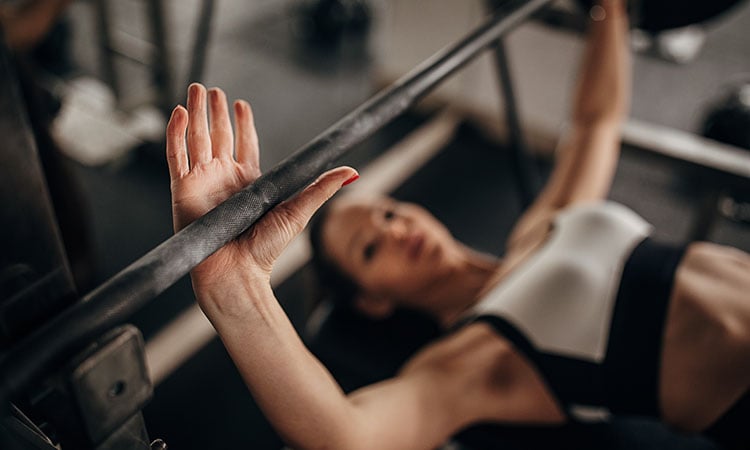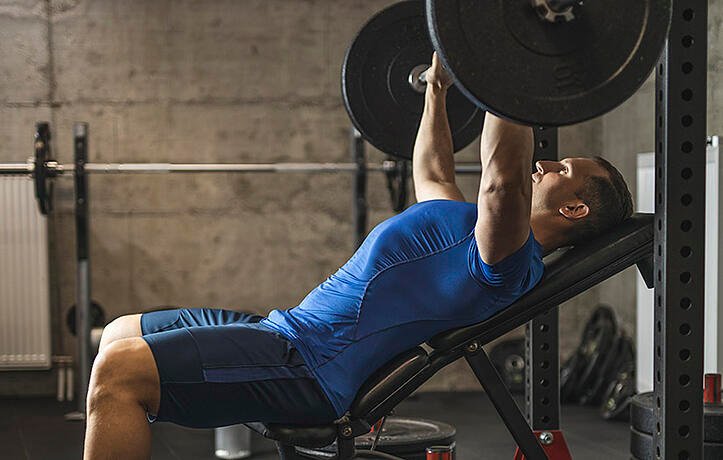By Andrew Mills
Anyone having experienced pain in their elbow while bench pressing knows it can be a frustrating ordeal.
For those who have not, imagine entering the gym ready to put in the work, and after loading the appropriate weight onto the bar, laying back on the bench, and visualizing the first rep, you lower the weight to your chest only to experience splitting pain on the inside of one or both elbows.
How can you prevent this from happening during your next bench press session?
This article will answer that question by providing the following:
- A brief overview of Lifter’s Elbow
- Some suggested bench press modifications to reduce symptom aggravation
- A sample warm-up routine to prepare the upper body for loaded movement and promote recovery
The information and strategies outlined in this blog post closely followed the underlying principles discussed in NASM’s online personal training course (NASM-CPT) – as well as the Corrective Exercise Specialization curriculum (NASM-CES).
WHAT IS LIFTER’S ELBOW?

Lifter’s elbow, perhaps more commonly known as golfer’s elbow, is an overuse injury. The tendons of the wrist flexor muscles become inflamed due to abnormal loading patterns and overuse (Ambler-Wright et al., 2021). A more technical name for this condition is medial epicondyle tendinopathy.
Tendinopathy occurs as a tendon experiences greater disrepair than it can recover from, possibly due to poor lifting biomechanics and other combinations of repetitive tasks, in this case, involving the wrist and forearm. Pain usually presents where the wrist flexor tendons attach to the bony part of the inside of the elbow (medial epicondyle), which can limit simple tasks.
Tendinopathy is one of the most frequently self-reported musculoskeletal disorders with many risk factors associated with it. Even with treatment, the recurrence of symptoms is common. Risk factors for tendinopathy include repetitive loading, excessive loading, abnormal and unusual movements (Kaux et al., 2011).
A FUNCTIONAL ANALYSIS OF THE BARBELL BENCH PRESS
A barbell bench press is a closed-chain exercise not allowing the distance between the hands to change. Because of the barbell bench press’s closed-chain nature, the forearms may begin perpendicular to the bar but will change in angle at the top and bottom portions of the press. If the client lacks mobility throughout the shoulder, forearm, or wrist, or is otherwise unable to stabilize the load, compensation will occur.
The barbell bench press requires proper shoulder mobility and stability to maintain proper kinetic chain checkpoint alignment. Proper mobility of the thoracic spine, scapular stability, and shoulder position are essential to the elbow and wrist’s overall function.
Because a muscle’s length will affect its ability to produce force, muscles that are overly lengthened or shortened may not be able to produce the necessary force to maintain a joint’s stability which leads to movement compensation as synergistic muscles take on a more dominant role (Ambler-Wright et al., 2021).
Janda’s upper crossed syndrome is an example of a postural distortion pattern that could compromise form and negatively affect the elbow during a bench press exercise. An individual with upper crossed syndrome may present with a forward head, hyperextended cervical spine, and rounded shoulders (Clark et al., 2018).
Individuals with upper crossed syndrome may also present excessive thoracic kyphosis, scapular winging, and elevated, rotated, or abducted shoulders (Ambler-Wright et al., 2021). If you want to learn more about correcting upper crossed syndrome, check out Correcting Upper Crossed Syndrome by NASM Master Instructor Ken Miller.
EMPHASIZING A NEUTRAL GRIP DURING THE BENCH PRESS

It is vital to maintain a neutral grip, which means the wrist should neither be flexed or extended, and the forearm should not be overly pronated or supinated. If you were to make a fist with each hand, with your thumbs up, the thumb should remain in-line with the upper arm. While you would not grip the bar or handle with your thumb out in this manner, the wrist and forearm orientation should be the same.
As an individual progresses to pressing heavier loads and greater training volume, the bench press resistance may begin to outpace grip strength, limiting the client’s ability to maintain a neutral grip orientation—, placing the wrist in extension during the press.
When the wrist is extended, the length-tension relationship between the wrist extensors and flexors becomes altered, limiting the wrist flexors’ ability to produce force. In such a state, the wrist flexor muscles and tendons may become unnecessarily strained, which may be especially true if the wrist flexors are overactive or shortened.
If the wrist flexors are shortened, they will not meet the wrist extension position’s demand. While the wrist flexors may be overactive, overactivity does not mean they are strong enough to maintain a neutral grip.
MODIFICATIONS FOR PROPER BENCH PRESS FORM
Depending on training goals, individual preferences, and capabilities, the bench press can be modified in a variety of ways; however, even with modifications focus on proper bench press form is essential. A barbell bench press should be performed with proper kinetic chain checkpoint alignment. For proper form, the client should be lying on a bench with their back against the bench.
The feet should be parallel, pointed straight ahead, and the low back should be neutral. It is ok to place a step or similar platform under the feet to maintain a neutral, low back position for those with shorter legs. Ideally, the hands should be placed in a manner that allows for a neutral wrist and the forearms to be perpendicular with the resistance, placing them over the chest (not the shoulders) for proper kinetic chain checkpoint alignment (Clark et al., 2018).
The exact distance the weight will be lowered during the eccentric portion of the press will be determined by the client’s ability to control the resistance and movement without shoulder, forearm, or wrist compensation. Common compensations to watch for would be shoulder elevation (shoulders shrugging toward ears) or anterior rotation (shoulders rolling forward and coming off the bench) during the exercise’s deceleration phase.
Unfortunately, due to the forearm’s required rotation to grip the barbell, barbell bench pressing can exacerbate the lifter’s elbow symptoms by requiring greater forearm pronation than the client may have available, adding stress to the medial inner aspect of the elbow.
While there are many innovative grip tools in development to mitigate the barbell’s complications, the CPT can utilize the barbell in their programming and reduce risks by ensuring optimal form and positioning throughout the exercise.
Lowering the intensity to match what the client can stabilize and control with proper technique is essential. However, in an ideal situation, modifications may be made enabling the. Client to achieve a stable lift with good technique and without compromising intensity while reducing the stress placed on the wrist flexors’ muscles and tendons.
BARBELL BENCH PRESS ALTERNATIVES
As already discussed, the barbell’s fixed path of movement and grip position can complicate the client’s ability to maintain a neutral grip. For this reason, other forms of the chest press may serve as a better alternative to the barbell bench press while still allowing for a significant training effect.
Dumbbells may serve as an appropriate alternative to barbells for the bench press. The dumbbells provide more freedom of movement, especially allowing for a more neutral forearm position. Please note that if the client lacks shoulder stability, they may find that dumbbells provide too much freedom of movement and lack control to perform the dumbbell bench press without reducing the weight safely.
Suppose a lack of mobility or stability is a concern. In that case, it may be more appropriate for the client to focus more on phases 1 and 2 of the NASM OPT Model to better prepare the body for stabilizing greater loads with better form and a neutral grip.
For example, a stability ball dumbbell chest press would be similar in posture to the flat bench press while also allowing the client to develop greater core and shoulder stability and enabling the neutral grip that is important for reducing symptoms of lifter’s elbow.
As the client develops and maintains greater stability and postural control while being exposed to progressive training loads, they will continue to progress towards their training goals while reducing overuse patterns within the forearm and elbow. This will allow the tendons and muscles of the forearm to recover more optimally or, at the very least, not make things worse.
Other alternatives include the use of resistance bands or cables in a standing or kneeling position. The importance of a neutral grip and proper kinetic chain checkpoint alignment with the lifter’s elbow condition should be emphasized whether the client is performing a standing cable press with phase 1 stabilization acute variables or phase 5 power variables . In addition to emphasizing exercise technique and the discussed modifications, a warm-up routine before lifting has many benefits.
SAMPLE BENCH PRESS WARM-UP ROUTINE
Some of the benefits of a warm-up include increased heart and respiratory rate, increased tissue temperature, and increased psychological preparation for bouts of exercise. Additionally, a flexibility component should be incorporated into the warm-up. Doing so will address any existing muscle imbalances, improve the musculotendinous junction’s extensibility, and improve neuromuscular efficiency and function (Clark et al., 2018).
Foam rolling and stretching are beneficial in a warm-up to address overactive and tight muscles that could be limiting mobility and the ability to maintain proper posture and alignment. Once the overactive muscles are addressed, then you can use specific exercises to target underactive and lengthened muscles to become more active can be performed.
Finally, the warm-up may conclude with any integration exercise intended to improve intermuscular coordination and movement patterning specific to the task(s) ahead (Ambler-Wright et al., 2021). Here is a sample warm-up routine following the NASM Corrective Exercise process :
FLEXIBILITY
Foam roll or massage ball: Latissimus dorsi, pectoralis major, biceps brachii, wrist flexors, and forearm pronators.
- Acute variables: Hold areas of discomfort, 4-6 repetitions of slow active joint movement, spending between 90 and 120 seconds per muscle group.
Static stretching: Thoracic Spine, Latissimus dorsi, pectoralis major, and biceps brachii.
- Acute variables: You should hold static stretches for 20-30 seconds.
ACTIVATION
Isolated strengthening: Ball combo I, and resisted triceps extension with a neutral grip and forearm position.
Acute variables: Using cable or band resistance and bodyweight 10-15 reps with a 4-second eccentric, 2-second isometric hold at end range, and a 1-second concentric tempo.
INTEGRATION
Integrated dynamic movement: A standing cable press or stability ball dumbbell chest press.
- Acute variables: 10-15 reps under control.
This warm-up routine should be performed prior to the client’s chest workout involving pressing exercises like the bench press and should take no more than 5-15 minutes to complete. The isolated strengthening exercises were chosen to activate common underactive muscles that would lead to shoulder compensation during a bench press.
Additionally, the standing cable press or stability ball dumbbell chest press is ideal for challenging the intermuscular coordination of the shoulder complex, forearm, and wrist throughout a pressing motion. If a client with lifter’s elbow successfully completes the warm-up without exacerbating symptoms, then they may be ready for more progressive loads if they can maintain proper form and technique.
KEY TAKEAWAY
Lifter’s elbow is an overuse injury in which the tendons of the wrist flexor muscles become inflamed due to abnormal loading patterns and overuse (Ambler-Wright et al., 2021). Even with treatment, the recurrence of symptoms is common. Risk factors for tendinopathy include repetitive loading, excessive loading, as well as abnormal and unusual movements (Kaux et al., 2011).
Unfortunately, due to the required rotation of the forearm to grip the barbell, barbell bench pressing can exacerbate the lifter’s elbow symptoms by requiring greater range of motion from the shoulder, forearm, and wrist than the individual may possess. Optimizing the forearm angle, promoting a neutral grip, and maintaining proper kinetic chain checkpoint alignment, can significantly reduce risk factors for elbow tendinopathy and lifter’s elbow symptoms, or at the very least prevent the worsening of symptoms while continuing to train.
By limiting movement-compensation at the shoulder, forearm, and wrist, in conjunction with medical intervention, if deemed necessary by the appropriate medical care provider, individuals with lifter’s elbow should be able to continue training and progress towards their fitness goals. Also, by utilizing an extended warm-up routine prior to lifting, the body can be better prepared to accommodate the demands of the bench press exercise and similar pressing movements.
IMPORTANT NOTE ABOUT CPT’S ROLE
Suppose you or your client are experiencing pain while working out. In that case, it is essential to note that a certified personal trainer (CPT) must not attempt to diagnose a medical condition or injury. CPTs should refer any client presenting symptoms of reoccurring pain at the elbow for proper diagnosis and treatment.
For more information on referrals and scope of practice, see The CPT’s Role Within a Circle of Care.
Although a CPT should not treat this condition, there is plenty a CPT can do to address underlying risk factors, such as faulty exercise technique, postural distortions, and lack of forearm and wrist mobility.
REFERENCES
Clark, M. A., Lucett, S. C., McGill, E., Montel, I., & Sutton, B. (Ed.). (2018). NASM Essentials of Personal Fitness Training. Jones & Bartlett Learning
Ambler-Wright, T., Annaccone, A., Behm, D. G., Brager, A., Cheatham, S. W., Clark, M., Fahmy, R., Frederick, C., Le Cara, E., Miller, K., Richey, R., Sorenson, E., Splichal, E., Stull, K., & Titcomb, D. A. (2020). NASM essentials of corrective exercise training (2nd ed.) (R. Fahmy, Ed.). Jones & Bartlett Learning.
Kaux, J., Forthomme, B., Le Goff, C., Crielaard, J., & Croisier, J. (2011). Current opinions on tendinopathy. Journal of Sports Science and Medicine, 10, 238-253. Retrieved from https://jssm.org
TAGS: FITNESS TAGS: SPOTLIGHT TAGS: BENCH PRESS
PREVIOUS POST
IS A CALORIE SURPLUS NECESSARY TO INCREASE SKELETAL MUSCLE MASS IN RESISTANCE TRAINED FEMALE ATHLETES?
THE AUTHOR

ANDREW MILLS
Andrew is an NASM Master Instructor with a masters in Exercise Science with emphasis on Rehabilitation and working on a doctorate in Health Science from CalU. He is a licensed massage therapist, an NASM Master Trainer and holds additional certifications from the National Academy of Sports Medicine (CNC, CES, PES, FNS, & BCS). Andrew has a passion for professional mentorship and education and works diligently to improve the fitness industry standard as a content developer, continuing education instructor and consultant for health and fitness professionals. You can reach him at: Andrew.Mills@NASM.org

